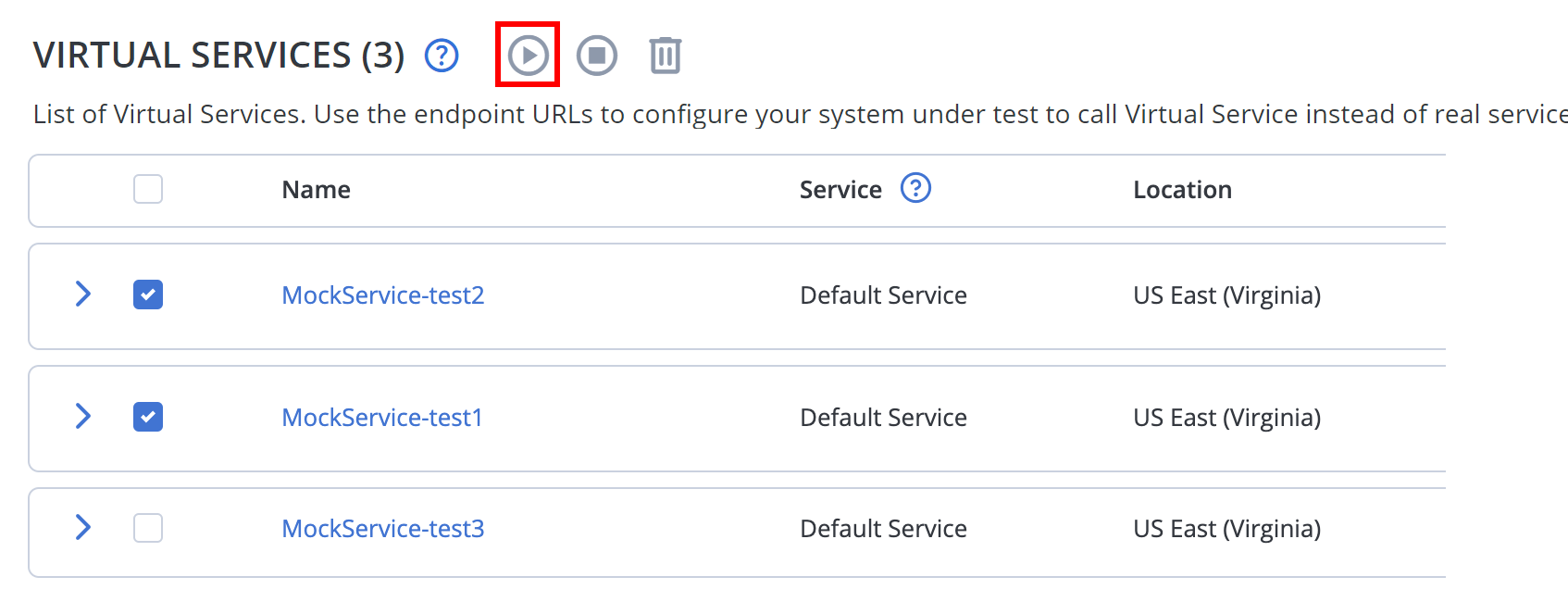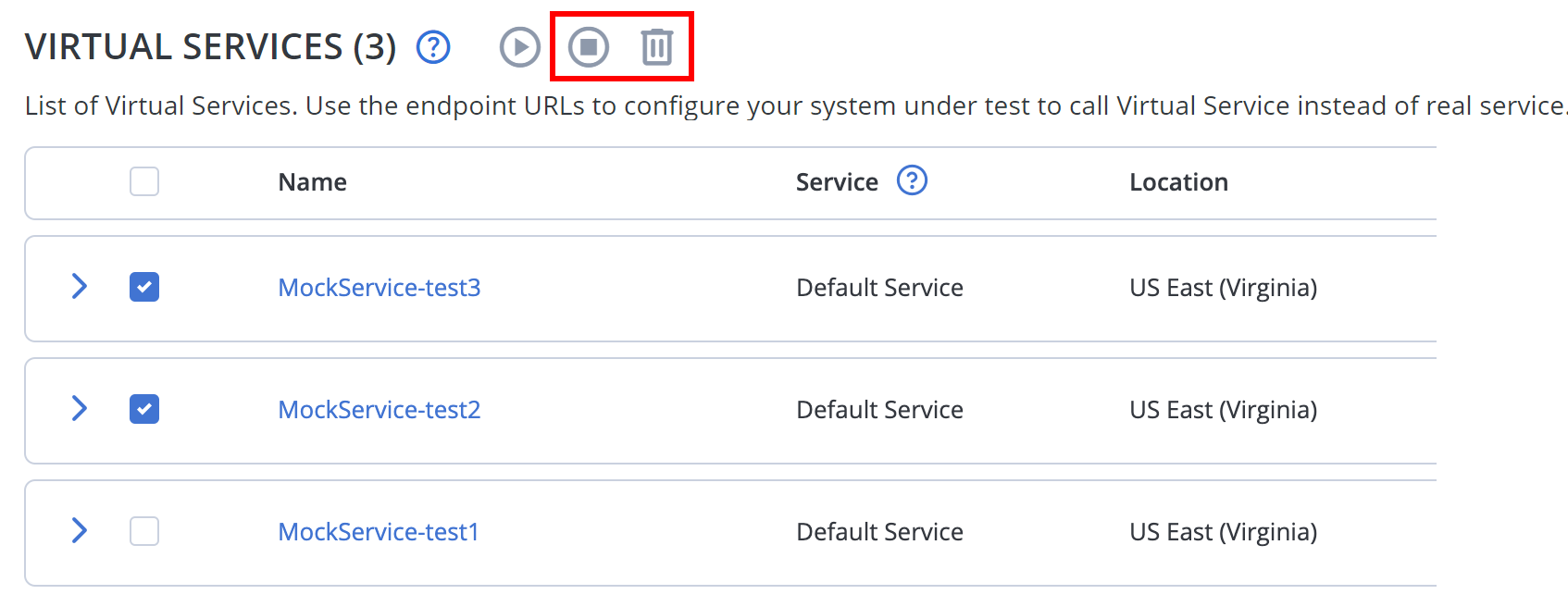Run a Virtual Service
Running a virtual service makes it available for you to test against. Running a virtual service is a simple two step process:
- Run the Virtual Service
- Connect your application to the running virtual service
Run a transaction-based virtual service
- Find your virtual service on the Service Virtualization tab and click Run.

The Status changes to Running, and the endpoint for the running virtual service appears. - Copy the endpoint for the virtual service and redirect your application to point to the virtual service instead of the real Service.
Do not refer to a Kubernetes-based virtual service by its plain IP address. - You implement the redirect configuration in your application, not within BlazeMeter. How you do it depends on your application. It's often as simple as changing a value in an application properties file from the live service address to the virtual service endpoint.
- After you redirect your application to the virtual service, restart the application.
The user and date when the virtual service was Created and Updated are indicated here for your reference. After you have run a virtual service at least once, no matter with which status (running, failed, stopped, configuring), the details view also indicates the Version of the image.
Filter virtual services by status
In the Virtual Services tab, you can filter the transactions based on their status. The filter helps in cases where there are many virtual services defined. By using this filter option, it is easy to display a subset of virtual services based on a certain status. For example, you can display only virtual services that are running or stopped.
Bulk run virtual services
You can bulk run virtual services from the Virtual Services tab or from the Asset Catalog tab.
- Click the Service Virtualization tab.
- Click Virtual Services at the top of the page.

- Find your virtual services on the Service Virtualization tab.
- Select the checkbox next to each virtual service that you want to run.
- Select the Run Virtual Services button next to the virtual service.

If one of the services is already running when you apply the bulk action, the Run Virtual Services button is disabled.
Conversely, if one of the services is in the stopped state, then bulk stopping is disabled.
Additionally, you can also delete virtual services in bulk.
Bulk actions are limited to deploying 25 virtual services at a time.
Configure SSL connection to virtual services
BlazeMeter can configure HTTPS connections to virtual services over TLS/SSL. When you run a virtual service over HTTPS, verify that your application can connect to the virtual service. You can connect your application using the SSL certificate that we provide.
Deploy virtual services to a cloud location
When you deploy a virtual service to a cloud location, it uses a certificate signed by the Let's Encrypt certificate authority.
If the application or browser you're using to access a virtual service does not trust certificates issued by Let's Encrypt, then you will need to configure it to trust the following certificates:
- Let’s Encrypt Authority X3 intermediate certificate
- DST Root CA X3 root certificate, which is used to cross-sign at the previous certificate
Refer to your application, language, or operating system documentation for details on how to import these certificates.
Deploy virtual services to a Private Location
When you deploy a virtual service to a Private Location, the HTTPS endpoint is based on the IP address of the agent that deployed the virtual service. No FDQN resolution occurs by default.
Use the following self-signed certificate to connect to a virtual service deployed to a private location:
-----BEGIN CERTIFICATE----- MIIC4jCCAcqgAwIBAgIEXSSpbDANBgkqhkiG9w0BAQsFADAgMR4wHAYDVQQDDBUq Lm1vY2suYmxhemVtZXRlci5uZXQwHhcNMTkwNzA5MTQ0OTE2WhcNNDYxMTIzMTQ0 OTE2WjAgMR4wHAYDVQQDDBUqLm1vY2suYmxhemVtZXRlci5uZXQwggEiMA0GCSqG SIb3DQEBAQUAA4IBDwAwggEKAoIBAQCoePRBvFbV5We4CmR/68AddxloEeH3oLeg ylZpZuPbQt0kEg93mYo4j1xvrTThS4gqCWg1bg7eh4pvVeNTUvTZf/BvCq4RGohG dfodFzHSuSNMVAhCrMmlUi+T3M4nrBjCj41ZgDB7bijMSbYhb5oOAqXHxLSNCgO/ 3UDlUwdbyTzlag0p5iu8spI6IoS6XtWR44h8Jm+WOkBSp7PIc8SMQC2xj5DWHrxx NlTTj9dC099jvvsR4ncelYNwQGEM5xj6HqTFdD6NGYkyV7r2egjl25uBbruC+M7k 1k4k5BgzuR4g/M1D9y0Yw1ezUvYMaT5g4aCSU5RV3ha4IBJaItZTAgMBAAGjJDAi MCAGA1UdEQQZMBeCFSoubW9jay5ibGF6ZW1ldGVyLm5ldDANBgkqhkiG9w0BAQsF AAOCAQEARRPDOPPHQgZCmNqamVcC4rjuG6Q5uDrOejg9uoI2iYHa4ScD8WZxKUy/ 7FTzYMBkBSb6NbhEJfIP/D7PL+MWG115080LM01WDdYN8Avjqx4ZlmyQyAwTsdKt hkGErTVqwiBjuDxjNosFi/0w1XeYIRdZ41iE5x9wqy0qio9pVyc30rwAimIbFFDc aKtLTEom3yAhj4vpBojN35YyEY6jnTkpQBcd4bnarwtqYvTbqiSIbMJivmTHl88e eWsSBE53G/u2aDPOyx+Lg24Rqh6I+ssgRVmNDZIc4Vj8cvEeTmihMVY6DTpwPls5 yuLi+DPQq6qM479piqLVP7LPV5vs/A== -----END CERTIFICATE-----
If you want to generate a hostname for the HTTPS endpoint, add an entry to your operating system's host file that lists the IP address followed by a host name that ends with mock.blazemeter.net.
Example:
10.1.1.100 testmock.mock.blazemeter.net